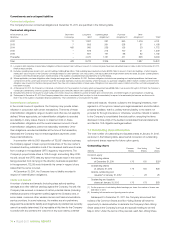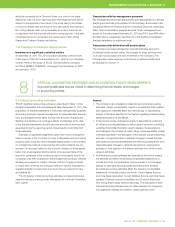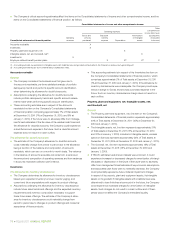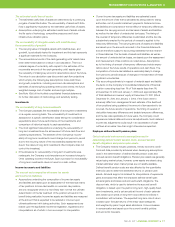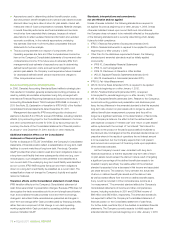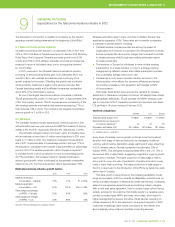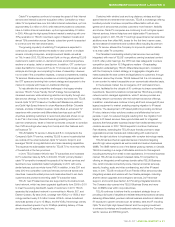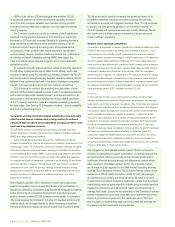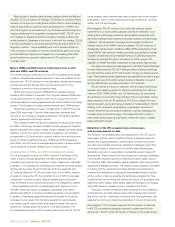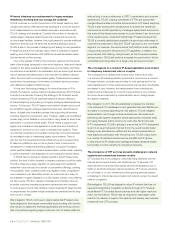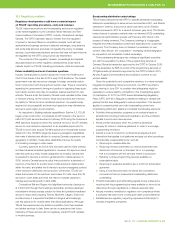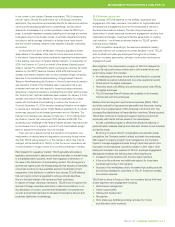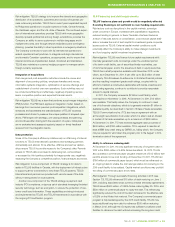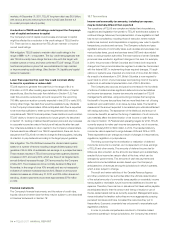Telus 2011 Annual Report Download - page 88
Download and view the complete annual report
Please find page 88 of the 2011 Telus annual report below. You can navigate through the pages in the report by either clicking on the pages listed below, or by using the keyword search tool below to find specific information within the annual report.
84 . TELUS 2011 ANNUAL REPORT
HSPA+ dual-cell and LTE technologies have enabled TELUS
to expand its selection of mobile devices and capability to roam in
more than 200 countries, establish and maintain a strong position
in smart phone and data device selection, and increase international
roaming revenue.
The Company continues to build on a variety of client experience
initiatives to bring greater transparency and simplicity to customers.
Initiatives in 2011 included: increased flexibility in upgrading handsets,
large reductions in international voice and data roaming costs for
customers without requiring a roaming plan, and wireless device
unlocking for certain postpaid SIM-based (subscriber identification
module-based) devices. Previous initiatives included: free notifications
of roaming and short messaging service (SMS) data usage, the
Clear and Simple Device Upgrade program, and a more transparent
cancellation policy.
To compete more effectively in serving a variety of customer seg ments,
TELUS offers a value service brand called Koodo Mobile, which was
launched in March 2008. By maintaining separation between the TELUS
and Koodo brands, through uniquely targeted value propositions, TELUS
believes it has positioned itself well in the face of increased competitive
intensity from new entrants and incumbent national competitors.
TELUS intends to continue the marketing and distribution of inno-
vative and differentiated wireless services; invest in its extensive network;
evolve technologies when deemed prudent; and acquire spectrum, as
appropriate, to facilitate service development and profitable expansion
of the Company’s subscriber base and address accelerating demand
for data usage. (See Section 10.3 Regulatory matters – Future availability
and cost of wireless spectrum.)
Competitor pricing and technological substitution may adversely
affect market shares, volumes and pricing, leading to reduced
utilization and increased commoditization of legacy wireline voice
local and long distance services
TELUS faces intense competition across all key business lines and
market segments, including the consumer, small and medium business
(SMB) and large enterprise markets.
Technological advances have blurred the traditional boundaries
between broadcasting, Internet and telecommunications. (See Section 10.2
Technology.) Cable-TV companies continue to expand offerings of digital
voice and enhanced phone services, resulting in intensified competition
in the residential and certain SMB, local access, long distance and HSIA
markets. Over-the-top (OTT) content providers like Netflix are expected
to compete for share of viewership, potentially cannibalizing TV and enter-
tainment services. However, TELUS views OTT services as a possible
complement to its Optik TV service offering. Overall, industry pricing
pressure and customer acquisition efforts have intensified across most
product and service categories and market segments, and this is
expected to continue.
Risk mitigation, general: CRTC decisions in recent years approving
wireline deregulation have provided TELUS with improved flexibility to
respond to intensifying competition (see Section 10.3 Regulatory matters).
Active monitoring of competitive developments in product and geo-
graphic markets enables TELUS to respond more rapidly to competitor
offers and leverage the Company’s full suite of integrated solutions and
national reach. As discussed below, to offset increasing competitive
intensity and losses in legacy services provided in its incumbent areas,
TELUS continues to invest in increasing the speed and reach of its
broadband networks, introduce innovative products and services,
and enhance services with integrated bundled offers. TELUS continues
to expand into and generate growth in non-incumbent markets in
Central Canada with business services and mobility offerings. TELUS
also continues to actively pursue a competitive cost structure and
invest in efficient operations.
Wireline voice and data competition
Competition is expected to remain intense from traditional telephony, data,
IP and IT service providers, as well as from entrants focused on voice
over Internet
protocol (VoIP) in both business and consumer markets.
The industry transition from legacy voice infrastructure to IP telephony
and from legacy data platforms to Ethernet, IP virtual private networks,
multi-protocol label switching IP platforms and IP-based service delivery
models continues at a robust pace. Legacy data revenues and margins
continue to decline and have been only partially offset by increased
demand and/or migration of customers to IP-based platforms. IP-based
solutions are also subject to downward pricing pressure, lower margins
and technological evolution. Capital investments in wireline infrastructure
are required to facilitate this ongoing transition process for all incumbent
local exchange carrier (ILEC) entities including TELUS.
Business
In the business market, price-discounted bundling of local access,
wireless and advanced data and IP services has evolved to include web-
based and e-commerce services, as well as other IT services and support.
Non-traditional competitors such as Microsoft have entered the telecom-
munications space through new products like Unified Communications,
which provides the ability to redirect and deliver, in real time, email,
voice and text messages from a variety of telecommunications and IT
systems to the device nearest the intended recipient. With this broader
bundling of traditional telecommunications services and IT services,
TELUS increasingly faces competition from pure Internet and IT hardware,
software and business process/consulting companies. Cable-TV
companies target the SMB market with their VoIP services. The result
is that traditional and non-traditional competitors are now focused on
providing a broad range of telecommunications services to the business
market, particularly in major urban areas.
Risk mitigation in the business wireline market: TELUS continues to
increase its capabilities through a combination of strategic acquisitions
and partnerships, a focus on priority vertical markets (public sector,
healthcare, financial services, energy and telecommunications whole-
sale), expansion of strategic solution sets in the enterprise market,
and a mass modular approach in the SMB market (including services
such as TELUS Business One and TELUS Future Friendly Office). Since
the launch of TELUS Health Solutions in 2008, TELUS has leveraged
its systems and proprietary solutions, as well as its reach and brand,
to extend the Company’s footprint in healthcare, benefit from the invest-
ments being made by governments in eHealth, bring to market services
targeted at consumers such as personal health records and tools to
manage their health, pursue the transformation of the Canadian pharmacy
benefit management sector and cross-sell more traditional telecommu-
nications products and services to the healthcare sector. TELUS is
also focused on implementing large enterprise deals that leverage the
Company’s capital investments and capabilities.


